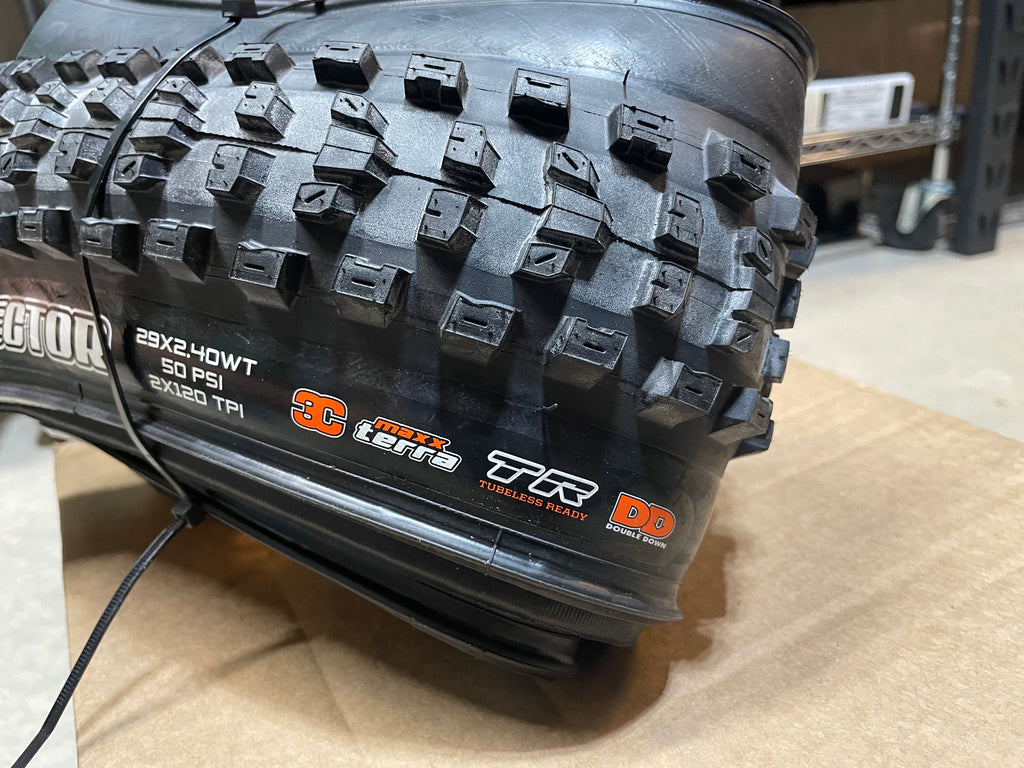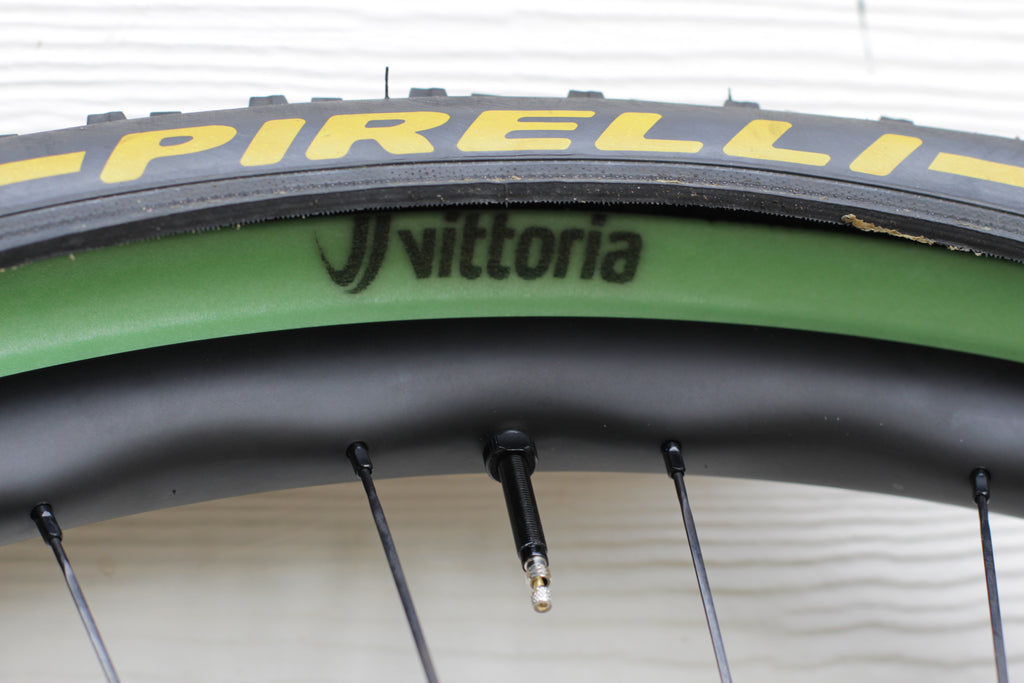
Your guide to all things MTB tires
It's a familiar scenario: Walk into your local bike shop, meander over to the tire wall and look at the options, and the information overload sets in immediately. Terms and designations like "DD", "ADDIX Speed", "TLR", "2 Bliss", "Smartwall", "EXO+", "Gravity", etc. wash over you like a wave, and It can be very overwhelming to try to figure out what tires you should be putting on your MTB. Fear not though, our tire guide is here to help! We'll go over important things like casings, tread patterns, compounds and widths, as well as the merits of running different tires front and rear.
What Kind Of Tread Should I Be Running?
The most important part of the tire selection process is picking your tread pattern. Ride type or terrain is a great starting point to determine what tires you should be looking at, and tires from most brands are organized into the XC, Trail, Enduro, and Downhill categories.
Consider, XC bikes are ≤120mm of travel, Trail bikes are 130-150mm, Enduro bikes are 160-180mm, and Downhill are 180mm+. These are rough guidelines you can use to start your tire search, and you can start narrowing down on a tread pattern and size based on the ride type.
The further towards the XC spectrum you go, the lower profile the tread will be. Smaller nobs and less material equal higher speeds. Enduro and Downhill tires are at the other end of the spectrum and will be the meatiest of the bunch, with huge lugs, lots of rubber, and a priority placed on traction. Trail tires fall in the middle; not the grippiest ever, but not the fastest rolling either, just the jack of all trades.
XC tires roll amazingly well, prioritizing speed and efficiency, but sacrifice traction to do so. The exact opposite is true of Enduro and Downhill tires, where the traction under braking is amazing, but rolling resistance is higher. Anything outside of steep, downhill grades may feel pretty sluggish.

Beyond the travel numbers on your bike, your ride style will also help dictate what kind of tires you'll want to choose. Let’s say you have an XC bike you want to push much more aggressively through rough terrain. There’s nothing stopping you from putting a mix of bigger Trail/Enduro tires on your XC bike to make it more capable. The same thing goes if you have a Trail bike that you want to make more manageable for long days. Put some lower-profile lugged tires on there, and enjoy that reduced rolling resistance! A good general guideline to go by is that the more efficiently oriented and smooth riding you're doing, the more XC-oriented you'll want your tires to be. The rougher your riding is, and the steeper the descents, the more you'll want to lean towards an Enduro or Downhill tire. If you fall somewhere in between, consider Trail tires or a front/rear mix.
The last factor to consider when selecting a tire tread pattern is your home dirt and weather. Tires with more and closely spaced tread will be for drier weather. Drier weather tires will also have slightly less spiky knobs. If what you ride is more loamy, or even muddy, you’re going to want to look for tires that have a tread pattern that’s more widely spaced to let the tire sink further into the softer soil, and shed mud and wet soil if needed. Knobs spaced farther apart prevent mud from packing the tread.

So Many Compounds And Casings!
Rubber compounds and casing types... Every tire has them, some riders are super picky about them, and some don't even know which ones they are running. "Compound" and "Casing" are terms that we also sometimes hear used interchangeably by some riders but, they are indeed different.
Casing refers to the sidewall, and base layers of the tire. Tires use layers of rubber with layers of fabric, Kevlar, or some form of threading in the center, or a lining of rubber protection, and then the outermost external layer. The thickness of these layers, composition, and thread count is referred to as the Casing.
Most tire companies usually offer casings made in three or four different variations. XC oriented tires have the lightest, and thinnest casings. Enduro and Downhill have the heaviest and thickest casings, and Trail tires fall in the middle. Thinner casings on XC tires help improve rolling resistance, have lower weight, and make the tire feel much more supple.
The "TPI" designations stands for threads per inch, and is also an important component of casings. The higher the TPI count, the more supple and lightweight a tire will be, while offering more sidewall support. But a higher TPI is also more puncture prone. XC tires will traditionally have TPI's that are 115+. Trail tires are more around 80 TPI, and Downhill/Enduro are 50-60 TPI.
As you move down the line from XC tires, Trail tires, and then all the way to Downhill and Enduro tires, casings will get thicker and thicker. Thicker casings are much less puncture prone, and overall more resilient. A thicker casing will also dampen the trail feel. The downside to a thicker tire casing is that they weigh more. Typically, a Downhill tire casing may weigh up to 65% or more than an XC race tire.

The term "compound" refers to the outermost rubber layer of the tire, the part that connects you to the ground. Compounds are based on the elasticity of the rubber composing the layer. The more XC oriented the compound, the harder the compound is. The more Downhill oriented the compound, the softer the rubber compound is. The “hard” or “soft” rubber compounds refer to the rubber's elasticity, or how fast the rubber conforms and rebounds.
A harder rubber compound will not have much movement to it, and rebound a lot faster, not conforming to the terrain as much as a softer rubber compound will. If you had three rubber balls, one ball made of a hard (XC) style rubber, one of a medium rubber, and one of a soft (Downhill) rubber, all of the same size, and dropped them from the same height, what would happen? In the theoretical scenario, the harder compound would rebound to almost the same height from where it was dropped. The medium compound ball would only bounce halfway back up, and the soft compound rubber ball would barely bounce at all.
When you ride a very soft compound, Downhill oriented tire through a rock garden, you will feel more planted and in control, while an XC style hard rubber tire will make you feel like you're bouncing all over the rocks.
All casing types have pros and cons. Harder rubber rolls much faster, and lasts and wears significantly longer. A very soft rubber compound will be the grippiest and corner the best, but can feel sluggish, roll slow, and wear much faster. Hard compounds also won't corner nearly as well in the opposite direction.
Trail or medium compound tires provide a happy medium for most riders. If your goal is efficiency and speed, or if you ride a lot of hard pack or rolling terrain, think about a harder compound tire. If you ride more in loamy or loose environments and steep trails, think softer. If you ride mixed terrain, or even rough, very dry terrain (think moab), use a trail style compound.

Widths And Combinations
Last but not least, tire combinations and widths... For most riders we encounter, a 2.4" width tire on the front and rear seems to work best. 2.4" tires have shown to be a great universal, almost magical size that works very well, and one that is chosen by XC heroes like Nino Schurter and Downhill superstars like Jackson Goldstone alike. 2.4” tires offer the best compromise between sizes for most situations. The exceptions to this rule are the extremes on both ends.
For wetter XC conditions, you might want to consider a 2.25” to help cut through mud. On the other hand, for Enduro or Downhill oriented situations, consider running a 2.5" width for some extra cornering finesse and sidewall support. Most riders who have been primarily Trail and Enduro riding for a while are already most likely using 2.4” tires. But the XC lovers out there should also consider trying out 2.4" tires. Even though it might raise the weight on your custom 21 lbs full suspension speed machine, the benefits far outweigh the weight penalty. 2.4" tires increase sidewall support, reduce punctures, and allow lower PSI. Plus, they are higher volume, and even have a lower rolling resistance. It sounds crazy, but it's true! Some of the most established pros out there seem to agree: Nino Schurter, 34 time world cup winner (along with his numerous other titles), and Keegan Swenson, the MTB, marathon and gravel extraordinaire, both run 2.4” tires for most rides and races.

You can also choose to combine tire widths to optimize performance. If you choose to do so, you will always want to use the wider tire up front and the narrower tire in the rear. The front tire is responsible for controlling and steering the bike, so higher cornering traction and more knob for the side is wanted in the front. The rear of the bike is also under more load, and your body weight will effectively widen the contact patch of the rear tire. The same rule applies to tread patterns. Bigger and more aggressive tires up front, and faster rolling in the rear. Running the same tire and width on the front and rear also generally works well though, and many riders prefer a matching setup. It's more a matter of personal preference and experience, rather than a "right or wrong" scenario.
Any Recommendations?
If you still are unsure of what tires to get, no worries! We're here to help. To get you started, here are some of our personal favorites, these have proven to be very balanced options that should serve you well.
XC
If you like to do nothing but race XC, and need a dedicated racing tire, check out the Maxxis Aspen 29 x 2.4. Maybe you still like XC, but you aren't racing? Consider the Specialized Ground Control 29 x 2.35.
Trail
Looking for a great all around Trail tire to get the job done? For the front tire, look at the Vittoria Mazza 29 x 2.4 . For the rear, the Maxxis Dissector 29 x 2.4 is a great option. Check it out.
Enduro
While there are plenty of great Enduro options available, our favorite front tire is the Maxxis Assegai 29 x 2.5. Or the Specialized Eliminator 29 x 2.6. Another solid bet for the rear is the Maxxis Minion DHR II 2.4 x 29.
There's a lot to consider when it comes to tires, but the number of great options out there make it a bit hard to go wrong. Let us know if we can answer any questions or help with further recommendations. Give us a ring at the shop, drop us an email or reach out on the chat and we'll help get you set up!
Excellent all-round article. Unusual in that it’s not brand specific. The best I’ve seen.
Tim King on